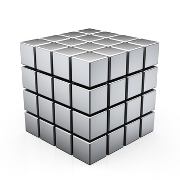Cell¶
Description¶
A Cell object stores the content of a Grid cell.
A cell can have styles, a dictionary of key-value properties attached to the cell.
A cell has a type to distinguish between header, body and footer cells. The default type is “body”, but you can also use “header”, “footer” or whatever…
A cell has top-left coordinates: x and y. The default coordinates is (1, 1): this is the top-left coordinate of the cell box. The coordinates x and y cannot be null: grid coordinates are 1-indexed.
A cell has a size: width and height. The default size is (1, 1), you can increase them to represent horizontal or vertical spanning. The width and the height cannot be null.
To instantiate a Cell, you can do:
>>> from benker.cell import Cell
>>> c1 = Cell("c1")
>>> c2 = Cell("c2", styles={'color': 'red'})
>>> c3 = Cell("c3", x=2, y=3, nature="footer")
>>> c4 = Cell("c4", width=2)
>>> c5 = Cell("c5", height=2)
The string representation of a cell is the string representation of it’s content:
>>> for cell in c1, c2, c3, c4, c5:
... print(cell)
c1
c2
c3
c4
c5
Attributes¶
A cell has the following attributes:
content is the user-defined cell content. It can be of any type:
None,str,int,float, a container (list), a XML element, etc. The same content can be shared by several cells, it’s your own responsibility to handle the copy (or deep copy) of the content reference when needed.styles is the user-defined cell styles: a dictionary of key-value pairs. This values are useful to store some HTML-like styles (border-style, border-width, border-color, vertical-align, text-align, etc.). Of course, we are not tied to the HTML-like styles, you can use your own styles list.
Note
The style dictionary is always copied: in other words, key-value pairs are copied but a shallow copy is done for the values (in general, it is not a problem if you use non-mutable values like
str).type is a way to distinguish the body cells, from the header and the footer. The default value is “body”, but you can use “header”, “footer” or whatever is suitable for your needs.
Using the cell attributes:
>>> paragraphs = ["Hello", "How are you?"]
>>> css = {'text-align': 'justify', 'vertical-align': 'top'}
>>> c1 = Cell(paragraphs, styles=css, nature="normal")
>>> c2 = Cell(paragraphs, styles=css, nature="normal")
# this will mutate the referenced *paragraphs* list:
>>> c1.content.append("I am well.")
>>> c2.content
['Hello', 'How are you?', 'I am well.']
# this will change only the cell styles:
>>> c1.styles['vertical-align'] = 'middle'
>>> c2.styles == {'text-align': 'justify', 'vertical-align': 'top'}
True
Properties¶
You can use the following properties to extract information from a cell:
use min to get the top-left corner coordinates,
use max to get the bottom-right corner coordinates,
use width to get the width of the box (number of columns),
use height to get the height of the box (number of rows),
use size to get the size (width and height) of the box.
>>> c1 = Cell("Hi", x=5, y=6, width=3, height=2)
>>> c1.min
Coord(x=5, y=6)
>>> c1.max
Coord(x=7, y=7)
>>> c1.width
3
>>> c1.height
2
>>> c1.size
Size(width=3, height=2)
Warning
All properties are non-mutable:
>>> c1.width = 9
Traceback (most recent call last):
...
AttributeError: can't set attribute
Operations¶
Contains¶
You can check if a point, defined by its coordinates (tuple (x, y) or
Coord instance), is contained in a
Cell.
A cell contains a point if it is in its Box.
This rule is explained in detail in the section Box – Contains.
>>> c1 = Cell("A", x=2, y=3, width=2, height=1)
>>> (3, 3) in c1
True
>>> (7, 9) in c1
False
Total ordering¶
A total ordering is defined for the cells. The aim is to order the cells in a grid sorted from left to right and from top to bottom. This order is useful to group the cells by rows.
The total ordering is base on the Box Total ordering.
>>> c1 = Cell("one")
>>> c2 = Cell("two", x=2)
>>> c3 = Cell("three", y=2)
>>> c1 < c2 < c3
True
This total ordering allow us to sort the cells:
>>> from random import shuffle
>>> cells = [c1, c2, c3]
>>> shuffle(cells)
>>> [str(cell) for cell in sorted(cells)]
['one', 'two', 'three']
Transformations¶
It is possible to change the cell position and size by using two kind of transformations:
Move a cell to a different coordinates,
Resize a cell.
>>> from benker.coord import Coord
>>> from benker.size import Size
>>> c1 = Cell("A")
>>> c1
<Cell('A', styles={}, nature=None, x=1, y=1, width=1, height=1)>
>>> c1.move_to(Coord(2, 3))
<Cell('A', styles={}, nature=None, x=2, y=3, width=1, height=1)>
>>> c1.resize(Size(3, 4))
<Cell('A', styles={}, nature=None, x=1, y=1, width=3, height=4)>
>>> c1.transform(Coord(2, 3), Size(3, 4))
<Cell('A', styles={}, nature=None, x=2, y=3, width=3, height=4)>
The transformation functions don’t change the current cell but produce a new one with new coordinates/size.
